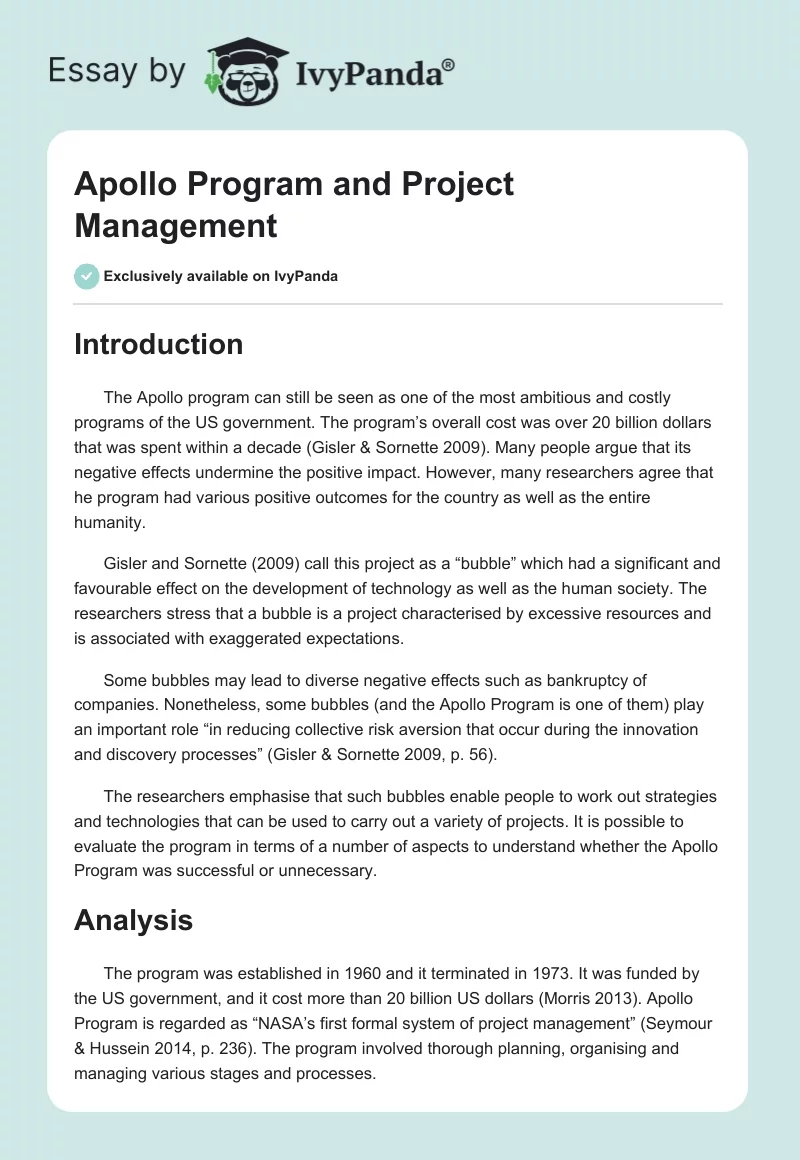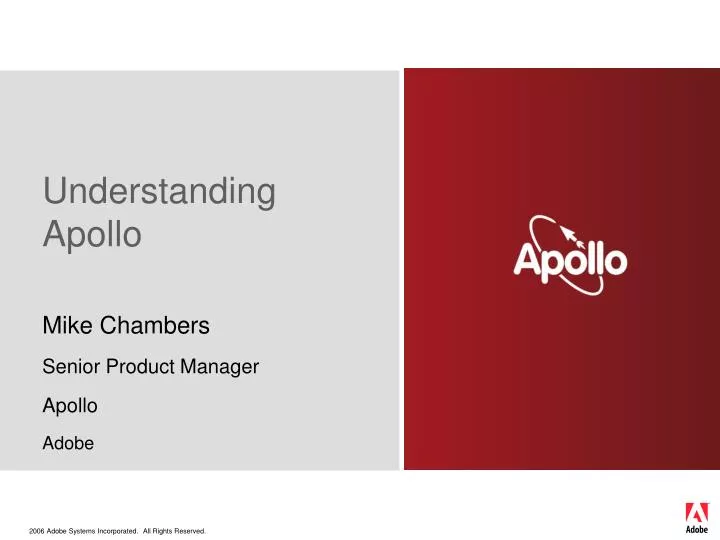Picture this: a bustling launchpad, a colossal rocket trembling with anticipation, and millions holding their breath as humanity embarks on an audacious mission – to land on the moon. The Apollo program, spanning over a decade, was a monumental undertaking that etched its name in the annals of history. But what exactly propelled this ambitious project to such breathtaking success? Was it a single, colossal feat of engineering, or a complex interplay of factors? The answer, as with most grand accomplishments, lies in a nuanced blend of ingenuity, dedication, and unwavering perseverance.

Image: ivypanda.com
This article dives deep into the intricacies of the Apollo program, dissecting the multifaceted components that contributed to its success. From the innovative technologies that pushed the boundaries of science to the unwavering spirit of the individuals who toiled tirelessly, we’ll unravel the captivating story of how humanity crossed the lunar threshold.
The Seeds of a Dream: Origins of the Apollo Program
A Race to the Moon: The Cold War Catalyst
The 1960s marked a period of intense rivalry between the United States and the Soviet Union, known as the Cold War. This ideological clash played a significant role in the Apollo program’s genesis. After the Soviet Union’s stunning success in launching Sputnik, the first artificial satellite, in 1957, the United States felt a pressing need to assert its technological dominance. This led President John F. Kennedy to declare in 1961, “I believe that this nation should commit itself to achieving the goal, before this decade is out, of landing a man on the Moon and returning him safely to the Earth.” This ambitious declaration, fueled by the competitive spirit of the Cold War, became the driving force behind the Apollo program.
Beyond Political Expediency: Pursuing Scientific Advancement
While the Cold War served as a catalyst for the Apollo program, it wasn’t solely about political victory. The moon landing, a scientific and technological marvel, held immense potential for deepening our understanding of the cosmos. Scientists eagerly awaited the opportunity to collect lunar samples, study the moon’s geology, and conduct unprecedented experiments in a foreign environment. This scientific curiosity, coupled with the drive to explore the unknown, served as a potent motivator, shaping the scope and objectives of the Apollo program.

Image: www.slideserve.com
Innovation and Engineering: Crafting a Lunar Journey
The Saturn V: A Monument to Human Ingenuity
At the heart of the Apollo program resided the Saturn V, a rocket of gargantuan proportions, an engineering marvel that carried the astronauts into space. The Saturn V was a testament to the American engineering prowess, combining incredible power with meticulous precision. The rocket was a three-stage behemoth, each stage fueled by a different type of propellant, meticulously designed to propel the Apollo spacecraft through the Earth’s atmosphere and eventually into lunar orbit.
Apollo Command and Service Modules: Piloting Through Space
The Apollo spacecraft, a marvel of technology, comprised three crucial modules: the Command Module, the Service Module, and the Lunar Module. The Command Module, which housed the crew of three astronauts, served as the control center for the mission, facilitating navigation and communication. The Service Module, attached to the Command Module, held vital components like the propulsion system, oxygen tanks, and power sources. And the Lunar Module, the vessel designed to land on the moon, carried the astronauts to the lunar surface and back to the Command Module.
Beyond the Rocket: Unprecedented Collaboration and Teamwork
The Apollo program wasn’t a solitary endeavor. It required the concerted effort of thousands of engineers, scientists, technicians, and skilled workers from diverse disciplines. NASA, at the helm of the project, orchestrated a symphony of collaborations, uniting universities, private industries, and government agencies to solve complex challenges. This collaborative spirit, fueled by a shared vision of lunar conquest, played a crucial role in the program’s success.
The Human Factor: Perseverance and Courage Amidst Risk
From Astronauts to Engineers: The Spirit of Exploration
The Apollo program stands as a testament to human resilience and courage. The astronauts, subjected to rigorous training and facing immense risks, embodied the spirit of exploration. They were pioneers, venturing into the unknown, pushing the boundaries of human capability. Likewise, countless engineers and scientists dedicated years of their lives to this program, fueled by a burning desire to reach for the stars.
Overcoming Setbacks and Challenges: A Legacy of Innovation
The path to the moon was not paved with smooth sailing. The Apollo program encountered numerous setbacks, from tragic accidents like the Apollo 1 fire to technical challenges that threatened mission success. These setbacks, however, did not deter the program’s progress but instead propelled innovation and fueled a relentless pursuit of solutions. The Apollo 1 fire, a catastrophic accident that claimed the lives of three astronauts during a launchpad test, served as a somber reminder of the inherent risks of space exploration. Yet, it spurred a comprehensive review of safety protocols and spurred the development of more robust safety features, making future missions safer.
The Triumph of the Human Spirit: A Defining Moment for Humanity
On July 20, 1969, as Neil Armstrong took his first steps on the lunar surface, the world witnessed a defining moment in human history. The Apollo program had succeeded. Against all odds, humanity had reached the moon, a testament to the power of human ingenuity, collaboration, and unwavering determination. The success of this audacious mission cemented the Apollo program’s place in history and continues to inspire generations with its legacy of innovation and exploration.
The Enduring Legacy of the Apollo Program
Inspiring Future Generations: A Catalyst for Scientific Exploration
The Apollo program’s success resonated far beyond the moon landing. It ignited a passionate flame for space exploration in the hearts of millions, inspiring a generation of scientists, engineers, and dreamers. The program served as a catalyst for scientific advancement, leading to breakthroughs in fields like materials science, computing, and space technology. Its impact on technology and culture is still palpable today.
Technological Spin-offs: A Ripple Effect of Innovation
The Apollo program, driven by the need for groundbreaking technologies, led to numerous spin-offs that have dramatically impacted our world. Advanced materials developed for the Apollo spacecraft, designed to withstand extreme temperatures and stresses, found applications in fields ranging from medical devices to sports equipment. The program also spurred significant advancements in computer technology, laying the foundation for the digital revolution we experience today.
A Catalyst for Global Collaboration: United in a Shared Vision
The Apollo program transcended national boundaries, fostering international collaboration in the pursuit of a shared goal. The program fostered partnerships with other nations, sharing technical expertise and contributing to the advancement of space exploration. This collaboration, born from the pursuit of scientific exploration, serves as a beacon of hope demonstrating the power of unity and cooperation in achieving shared aspirations.
Beyond the Moon: The Future of Exploration
Building upon the Legacy: A New Era of Discovery
The Apollo program laid the groundwork for a new era of space exploration. Building upon the lessons learned and technologies developed during the Apollo era, scientists and engineers are pursuing ambitious goals like establishing a permanent presence on the moon and venturing to Mars. The spirit of exploration that propelled the Apollo program continues to drive humanity’s quest to unravel the mysteries of the cosmos.
What Made Apollo A Success Pdf
A Source of Inspiration: Embracing Challenges and Reaching for the Stars
The Apollo program stands as a timeless reminder of the power of human ambition and the transformative potential of collaborative efforts. It teaches us that even the most daunting challenges can be overcome with a combination of ingenuity, dedication, and a shared vision. Its legacy prompts us to embrace challenges, push boundaries, and reach for the stars, reminding us that with a little bit of audacity and an unyielding spirit, anything truly is possible.
As we venture further into space, carrying the torch of Apollo, we are reminded that the journey of exploration is never truly over. The Apollo program serves as a beacon, guiding us towards a future where the stars are no longer just a distant twinkling but a beckoning invitation to reach out and embrace the wonders that lie beyond.




